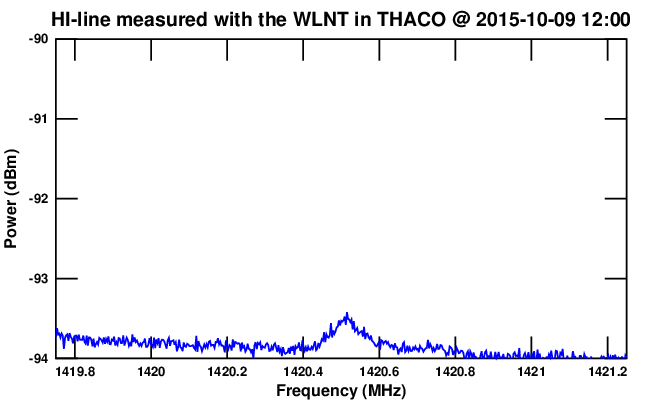Daily Image
20-01-2016The Wideband Low Noise Tile - The HI-line over five days
| Submitter: | Martijn Brethouwer, Bert Woestenburg, Roel Witvers |
| Description: | To conclude the current chapter in the development of the WLNT, a new measurement session was in order. The goal of this measurement session was to verify if the WLNT produced stable results over longer periods of time (days). But, before these measurement could take place some preparations were necessary. The front-end of the WLNT consists of bare electronics and had to be shielded from precipitation. This was done by using one of the old radomes of THEA which in the mean time had been used to cover the sandpit in the garden of one of the ASTRON employees. To provide insight in the environmental conditions, temperature and humidity loggers were placed at multiple locations and the WLNT power consumption was monitored. To prevent that one of the ASTRON employees should stay at the measurement site over night to perform the measurements, this task was delegated to a PC. Every 20 minutes a new measurement of the HI-line was made and in between of these measurements a much wider spectrum was captured to provide insight in the present RFI conditions. Multiple measurement sessions have taken place and all produced satisfactory results, the WLNT functioned flawlessly throughout changing temperatures and humidities. Our longest measurement session spanned 5 days and produced a very nice view of the HI-line emissions of the Milky Way over time and frequency. Every day at around 18:00 hrs the Milky Way rises above the horizon and a bump becomes visible in the measured spectrum. This bump moves slightly up in frequency due to the doppler effect, and disappears at 12:00 hrs when the Milky Way sinks below the horizon again. This image has been created with the data from 364 separate measurements. Each measurement consisted of 501 frequency points and each point had a bandwidth of 3 kHz and has been integrated over 2 seconds. The rise of the noise floor in the image over the 5 day span of the measurement session, is due to changes in the outside temperature. The temperature dropped by almost 10 degrees which resulted in an increase in gain of the WLNT. |
| Copyright: | ASTRON |
| Tweet |  |
